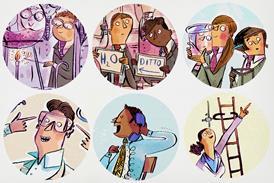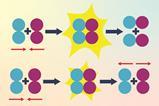Three ways to link thematic strands of the chemistry syllabus together to consolidate your 14–16s understanding and build their exam confidence

As teachers, we face the constant challenge of splitting precious class time between consolidating past content and covering the full sprawling syllabus. Along the way we must prepare learners for the exams themselves, where they must be able to swiftly switch between different topics, sometimes within a single question. Fortunately, there is a way to achieve it all; by finding strands of different themes as they weave through the course and making connections between them.
By linking different experiments, learners view them not as individual activities, but as parts of a bigger story
Connecting the strands of a theme can bring together topics that seem unrelated and create a hook for new content while revisiting old material. For example, many experiments in the students’ practical work are relevant to several areas of the course. Helping learners find the links can enhance their understanding of the context and chemistry behind a new experiment. This familiarity and understanding boosts their confidence, increases engagement and prepares them for exams. Exam questions about experiments can challenge students, who often struggle to connect theory with practice. By linking different experiments, learners view them not as individual activities, but as parts of a bigger story.
The most useful strands to weave together will depend on the level of your learners. Here are three ideas which have worked well for me and my 14–16 classes.
1. Experiments involving salt
When you introduce an experiment involving the use or preparation of salts, ask students to explain what a salt is and identify other experiments that involve salts, starting with their preparation. Many will offer neutralisation. Can they link this to salt preparation by acid–alkali titration? Can they remember the steps involved in preparing a salt by adding excess insoluble base or metal to dilute acid?
Next, ask learners about the reactants and products in a precipitation reaction, and whether salts are reactants or products in electrolysis. They may have calculated the rate of reaction of a metal and acid. Discuss as a class how this is similar and different to neutralisation.
2. Metal compounds
Metals dominate the periodic table and appear in numerous contexts throughout chemistry courses. When they appear in a new topic, prompt students with revision questions about metal compounds in general and ask them to apply their knowledge to the compound in question. Examples of questions to ask include:
- What type of bonding do metal compounds exhibit? Are there exceptions? How does bonding affect their physical properties?
- How do you determine the formula of a metal compound?
- How do you calculate the percentage by mass of a metal in a compound?
- Is the metal compound in question likely to make a good fertiliser, or affect pH? Could you use it in any experiments, such as investigating the rate of reaction or finding the concentration of an acid?
Making connections between concepts is a form of elaboration that aids understanding
3. Oxygen and oxides
Oxides offer another chance to check for key understanding around valency, bonding and properties. You can then ask learners to apply that understanding by asking questions such as:
- Why are some oxides gases and others solids?
- How many oxides can you name that are found in the Earth or Earth’s atmosphere? Which ones are soluble? Would they affect the pH of water?
- Which oxides are problematic in the atmosphere?
Coming together
Sometimes I ask learners to work collaboratively to find strands of a theme themselves. Students work first in pairs and then share their thoughts in small groups. This can become a team competition, where I award points for finding the most threads. As students explain concepts to each other, they reinforce their knowledge and enhance their understanding.
This style of learning combines several features of effective revision. Using retrieval practice, spacing revision over time and interweaving different topics in the same session all aid knowledge retention. Additionally, making connections between concepts is a form of elaboration that aids understanding. Connecting these thematic strands throughout the year takes minimal time away from exploring new content and provides an easy way to review past material. Best of all, when students are required to jump from titration to percentage composition in the exam hall, they will be ready.
Kate Comisso














No comments yet